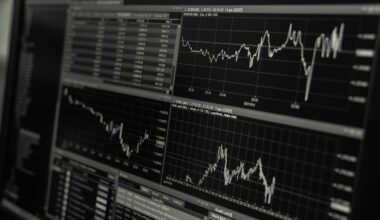Developing an Effective Internal Control Framework
Internal control frameworks are vital for organizations to ensure efficiency and compliance with laws. By developing an effective internal control framework, businesses can protect their resources from misappropriation and fraud. Key components of such a framework include risk assessment, control activities, information and communication, and monitoring activities. Implementing these components requires a systematic approach and commitment from the top down. Engaging employees and providing proper training can enhance awareness of internal controls and their importance. Regular assessments of the internal control framework ensure it evolves with business needs and regulatory changes. Organizations must also report and document their internal control processes effectively. This documentation serves as a reference for audits and helps identify areas for improvement. By embracing a proactive stance on internal control, companies can mitigate risks that threaten financial integrity and operational effectiveness. Additionally, integrating technology can enhance monitoring and reporting efficiency. For instance, software solutions can automate data collection and provide real-time insights, benefiting decision-making. Overall, a robust internal control framework is essential for long-term sustainability and growth.
The risk assessment process is critical to developing an effective internal control framework. This process involves identifying potential risks that could negatively impact an organization’s objectives and operations. By understanding these risks, businesses can prioritize them and develop corresponding control measures. Conducting a thorough risk assessment involves various steps, including identifying inherent risks, evaluating existing controls, and determining the effectiveness of those controls. Engaging employees in the process can provide valuable insights and enhance the quality of the assessment. Furthermore, organizations should regularly revisit their risk assessments to adapt to changing circumstances like market dynamics or external threats. This adaptation is crucial, as the risk landscape evolves over time. Specialized tools can also assist in assessing risks, allowing for more accurate and granular evaluations. Adequate documentation of risk assessments is necessary, as it supports accountability and transparency. Additionally, organizations can share their findings with stakeholders, fostering trust and collaboration. Regular communication about risks and control measures strengthens the overall internal control environment. To summarize, effective risk assessment is foundational in building a resilient internal control framework.
Control Activities and Their Implementation
Control activities are the policies and procedures that ensure management directives are carried out effectively. They provide direction for ensuring that risks are mitigated and that objectives are achieved in various operational areas. To develop effective control activities, organizations should consider the specific risks identified during the risk assessment process. This ensures that each control is relevant and effective in mitigating the corresponding risk. Control activities can be classified into preventive, detective, and corrective measures, each serving a distinct function in the internal control framework. Preventive controls aim to prevent errors before they occur, while detective controls identify issues after they happen. Corrective controls are then implemented to rectify identified issues. Regularly reviewing these control activities is essential for their continued effectiveness, as operational environments continuously change. Organizations must encourage a culture of compliance and accountability among employees to promote adherence to these controls. This involves providing training and resources related to internal controls. Additionally, organizations should utilize technology to automate control activities where feasible. Automation can significantly enhance efficiency and accuracy while reducing manual intervention. Ultimately, well-structured control activities strengthen the overall internal control framework.
Effective information and communication are crucial in ensuring that internal controls function optimally. To support good internal control, organizations must foster open lines of communication regarding control activities and risks. This communication should occur at all levels, promoting a culture of transparency and trust. Ensuring that relevant information reaches the right individuals promptly enhances decision-making and accountability. Organizations should establish clear channels for communicating control responsibilities and expectations, making it easier for employees to share insights and concerns. Regular training and updates related to internal controls and risks fortify this communication process. Additionally, documentation of policies and procedures must be accessible, supporting both current employees and new hires in understanding their roles in the internal control framework. Use of modern communication tools can significantly facilitate information sharing, especially in larger organizations. Furthermore, organizations should actively solicit feedback from employees about potential improvements to internal controls. This feedback loop can uncover gaps or weaknesses not previously identified, leading to better risk management. In conclusion, prioritizing communication and information sharing is fundamental to optimizing internal controls.
Monitoring Activities and Continuous Improvement
Monitoring activities are essential in a robust internal control framework, as they ensure that controls remain effective and relevant over time. Regular monitoring allows organizations to detect control deficiencies or shortcomings proactively. This ongoing evaluation can take various forms, including internal audits, periodic reviews, and continuous management oversight. Establishing clear metrics and objectives for monitoring functions can enhance their effectiveness and align them with business goals. Additionally, integrating technology can streamline monitoring processes, enabling real-time tracking of internal controls. For instance, automated reporting tools can provide management with insights about compliance and control performance without overburdening staff. Organizations must foster a culture that views monitoring as an integral part of continuous improvement rather than a punitive measure. This positive approach encourages employees to engage with internal controls actively and report issues or observations. Regular management reviews of monitoring results will help to reinforce accountability and drive action on identified weaknesses. These reviews should be documented to support a learning organization that continually refines its internal control processes. Ultimately, a commitment to ongoing monitoring and improvement is vital for sustaining an effective internal control framework.
Engaging stakeholders in the development and evaluation of an internal control framework is essential for ensuring its success. By including diverse perspectives, organizations can enhance their internal controls and increase buy-in from various departments. Stakeholders may include employees, management, auditors, and external parties, all of whom can provide valuable insights. Conducting periodic meetings or workshops to discuss internal control matters can facilitate collaboration and knowledge sharing. It encourages employees to take ownership of their roles in maintaining effective controls. Moreover, organizations can conduct feedback surveys to gauge stakeholder perceptions of the internal control framework, determining areas for improvement. Transparency in reporting any findings from these engagements is vital as it fosters trust and accountability throughout the organization. Stakeholders should also be informed of any changes to internal control policies, ensuring everyone understands their responsibilities. Leveraging technology such as collaborative platforms can enhance engagement and keep all stakeholders informed in real time. When stakeholders work together towards common goals, they create a more robust internal control environment that supports organizational integrity and compliance. Overall, stakeholder engagement is a pillar of a successful internal control framework.
The Role of Technology in Internal Controls
Technology plays an increasingly critical role in enhancing internal controls within organizations. Innovative solutions can streamline processes, automate tasks, and provide real-time insights, contributing to better risk management and decision-making. By automating routine control activities, businesses can minimize human error and maximize efficiency. Various software applications are available to assist organizations with monitoring their internal controls and generating compliance reports more quickly. Additionally, advanced data analytics can help identify trends and anomalies that require further investigation, thereby enhancing overall risk assessment efforts. Ensuring data security is paramount, as risks related to cybersecurity must be addressed within an internal control framework. Implementing appropriate technological measures protects sensitive information and maintains the integrity of internal controls. Furthermore, organizations should continuously evaluate their technology to ensure it aligns with best practices and evolving risks. Training employees on the use of technology in relation to internal controls is equally important, as it empowers them to utilize tools effectively. Ultimately, a strategic approach to technology integration can substantially strengthen internal control frameworks, improving operational efficiency while reducing risk exposure.
In conclusion, developing an effective internal control framework is essential for sustaining organizational integrity and compliance. By understanding the components of internal control, including risk assessment, control activities, information sharing, and monitoring, organizations can build a comprehensive system that addresses various risks. Engaging stakeholders at every level fosters a culture of accountability and transparency, ensuring that internal controls remain effective. Additionally, leveraging technology can enhance monitoring and reporting capabilities, improving overall efficiency. Regular reviews and assessments ensure that the framework adapts to the ever-evolving business environment. Proactive management of internal controls not only protects assets but also enhances decision-making processes. Establishing a robust internal control environment requires ongoing commitment from leadership and staff alike. Organizations that prioritize internal controls position themselves for long-term success and sustainability. As compliance pressures increase, having a solid internal control framework will differentiate leading organizations from those that struggle. Therefore, organizations must invest time and resources into developing and refining their internal controls. Such an investment not only contributes to financial integrity but also supports overall organizational goals and objectives.


